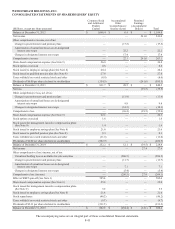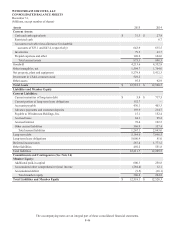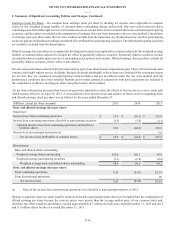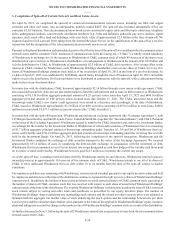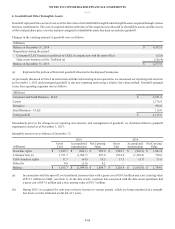Windstream 2015 Annual Report Download - page 181
Download and view the complete annual report
Please find page 181 of the 2015 Windstream annual report below. You can navigate through the pages in the report by either clicking on the pages listed below, or by using the keyword search tool below to find specific information within the annual report.
NOTES TO CONSOLIDATED FINANCIAL STATEMENTS
____
F-51
2. Summary of Significant Accounting Policies and Changes, Continued:
Accounts Receivable – Accounts receivable consist principally of trade receivables from customers and are generally unsecured
and due within 30 days. Expected credit losses related to trade accounts receivable are recorded as an allowance for doubtful
accounts in the consolidated balance sheets. In establishing the allowance for doubtful accounts, we consider a number of factors,
including historical collection experience, aging of the accounts receivable balances, current economic conditions and a specific
customer’s ability to meet its financial obligations. When internal collection efforts on accounts have been exhausted, the accounts
are written off by reducing the allowance for doubtful accounts. Concentration of credit risk with respect to accounts receivable
is limited because a large number of geographically diverse customers make up our customer base. Due to varying customer billing
cycle cut-off, we must estimate service revenues earned but not yet billed at the end of each reporting period. Included in accounts
receivable are unbilled receivables related to communications services and product sales of $41.5 million and $40.2 million at
December 31, 2015 and 2014, respectively.
Inventories – Inventories consist of finished goods and are stated at the lower of cost or market value. Cost is determined using
either an average original cost or specific identification method of valuation.
Prepaid Expenses and Other Current Assets – Prepaid expenses and other current assets consist of prepaid services, rent, insurance,
maintenance contracts and refundable deposits. Prepayments are expensed on a straight-line basis over the corresponding life of
the underlying agreements.
Broadband Stimulus Grants – Capital expenditures related to the broadband stimulus grants were initially recorded to construction
in progress. A receivable totaling 75 percent of the gross spend, representing the expected reimbursement from the RUS was
recorded during the same period, offsetting the amounts recorded in construction in progress. The resulting balance sheet
presentation reflects our 25 percent investment in these assets in property, plant and equipment. Once placed into service,
depreciation of the asset was calculated and recorded based on our 25 percent investment in the equipment. Initial outlays to
purchase stimulus-related assets have been presented as outflows in the investing activities section of the consolidated statements
of cash flows. Grant funds received from the RUS have been presented as inflows in the investing activities section of the
consolidated statements of cash flows. As of December 31, 2015, we had received all amounts due from the RUS related to these
grants.
Connect America Fund Support – In conjunction with reforming USF, the Federal Communications Commission (“FCC”)
established the Connect America Fund (“CAF”) which provides incremental broadband funding to a number of unserved and
underserved locations. CAF includes both short-term (“ CAF Phase I”) and a longer-term (“CAF Phase II”) framework. We received
$86.7 million in CAF Phase I support for upgrades and new deployments of broadband service. Pursuant to commitments we
made with the FCC, we agreed to match, on at least a dollar-for-dollar basis, the total amount of CAF Phase I support we received.
As construction projects which utilized CAF Phase I support were initiated, a portion of the CAF Phase I support received was
reclassified from other liabilities as an offset to construction in progress to effectively reduce the capitalized cost of the constructed
asset. For each construction dollar we spent, an equal amount was transferred from other liabilities to construction in progress to
reflect our dollar-for-dollar matching requirement. As of December 31, 2015, we had utilized all CAF Phase I support we had
received. Comparatively, as of December 31, 2014, $53.9 million of CAF Phase I support was recorded in other current liabilities
and $20.0 million was recorded in other liabilities, in the accompanying consolidated balance sheet. CAF Phase I support received
and used to construct network assets during the period has been presented within the investing activities section of the consolidated
statements of cash flows.
On August 5, 2015, we notified the FCC of our acceptance of CAF Phase II support of approximately $175.0 million per year for
a six year period to fund the deployment of voice and high-speed Internet capable infrastructures for approximately 400,000
eligible locations in 17 of the 18 states in which we are the incumbent provider. The CAF Phase II support in these 17 states will
substantially replace funding we received under the federal USF high-cost support program. We declined the annual statewide
funding in one state, New Mexico, where our projected cost to comply with the FCC’s deployment requirements greatly exceeded
the funding offer. We will be eligible to participate in a competitive bidding process for the CAF Phase II support in New Mexico,
along with other interested eligible competitors under an auction process administered by the FCC, which is expected to be held
during 2016. We will continue to receive annual USF support in New Mexico frozen at 2011 levels until the CAF Phase II
competitive bidding process is completed. Funds received under CAF Phase II are recognized as service revenues ratably over
the period to which the funding pertains.




